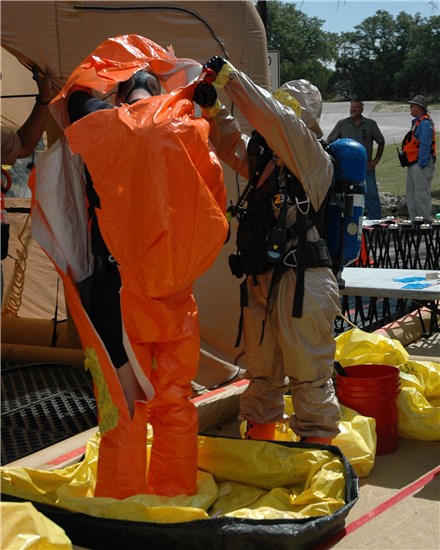 |
| Sgt. 1st Class Kerry Goering slits Sgt. Jared Brooks' hazmat suit open so he can exit at the technical decontamination station during an evaluation by Army North while Steve Wisniewski watches. The evaluation certifies the 6th CST with both the National Guard Bureau and the state of Texas as proficient in incident response procedures and protocols. (Photograph by Staff Sgt. Jennifer D. Atkinson, 56th Infantry Brigade Combat Team) |
Story by Staff Sgt. Jennifer Atkinson
SAN ANTONIO, Texas (Sept. 25, 2014) - With long shadows cast across the blank theater screen and orange plastic hazmat suits glowing in the glare of portable halogen lights, two Soldiers from the 6th Civil Support Team, Texas Army National Guard, moved slowly through the dark building, searching for the device prompting this “incident response.”
Circling an out-of-place orange safety cone, Sgt. Jared Brooks radioed details back to the command post, confirming the target, while Staff Sgt. Jorge Hernandez stood at a safe distance. Both steadily ignored the shrill beeping of monitors nearby to concentrate on the cone.
Turning the cone over, Brooks uncovered a nest of wires, batteries and containers, taped together in a dangerous tangle - the source of the toxins causing alarm.
Nearby, evaluators from Army North watched every move, from the approach of the building, to the use of various monitoring devices, to the search to the contact with the command post. At each step, Brooks or Hernandez answered questions about proper procedures, such as marking the door to indicate the team had moved through it, or how to notate each cleared area.
For Brooks and Hernandez, this was more than training, this was an evaluation of all the hard work and training in the past year- not just theirs individually, but the Austin-based CST as a whole.
“Right now, we're watching to make sure they're doing it right,” said Anthony Elmore, an ARNORTH evaluator. With tightly-controlled doses of reactive chemicals to set off the detection equipment, the realism is increased, he said. The evaluation is to certify to the National Guard Bureau that the CST is proficient in standardized incident response procedures.
“The gases make it harder, gives them a time-constraint. These guys have to make real-time decisions, just like they would in real life. There's not a lot of time to sit and think about it” he said, as his fellow evaluator hooked up a detector to a clear bag containing reactive gas. “It's not going to hurt anyone, but it makes it a lot more real.”
Neutralizing the threat might seem like the biggest hurdle to clearing a site, but for Brooks, just finding the object can be daunting.
“It's not always easy to find,” said Brooks. “There's a lot of room out there to hide in,” he said, gesturing to the theater and surroundings.
After finding and clearing the hazard, Brooks and Hernandez head outside to the technical decontamination area, manned by Sgt. 1st Class Kelly Goering, another CST member suited up in a tan plastic suit, a bright blue oxygen tank on her back. The technical decontamination area is for the responders, said Goering, rather than larger numbers who might have been affected.
“We're trying to get the Soldiers out of the affected suits without contaminating them, or spreading any more contamination, as we do it,” she said.
In the entrance to the decontamination tent, Hernandez slipped his boots off, scrubbing down with water while standing in a large rubber catch basin. Coming out of the tent, Goering swabbed his suit, testing it for remaining residue. The suit was slit open and folded down on itself open so Hernandez could exit without contamination from the outside of the suit.
Still wearing an oxygen tank and face mask, his clothing soaked with sweat from the heat inside his suit, Hernandez waited to one side while Brooks followed the same procedure, then both headed off to the medics to get a post mission checkup. Evaluators nearby watched each step closely, making sure Goering cleared each Soldier to proceed to the next step.
Since the bright orange suits are “level A” suits, rated for vapors, Goering's suit was a “level B” suit, rated for splashing hazards.
“Ideally, the vapor would have dissipated between the buildings and here, so that's not really a threat to me,” she said. “But if it hasn't and it gets in the water, the level B suit protects me.”
The CST isn't just about detecting threats, said Col. Lee D Schnell, commander of the 136th Maneuver Enhancement Brigade.
“Their capabilities are as sophisticated as any out there, especially the mobile lab. It's as good as anything you'll find at a university or college.”
Although there were no civilian partner agencies on site for the evaluation, the CST is closely integrated with the first responder community.
“This team gives smaller communities a resource they might not have access to normally,” said Schnell. “Larger cities have fire departments with the equipment, but little towns don't, so we can help them if they need it.”
The year-round training shows in the high level of skill throughout the CST, said Schnell.
“If I had one thing to tell someone about the CST,” he said. “It's that they're professionals. Just absolute professionals.”